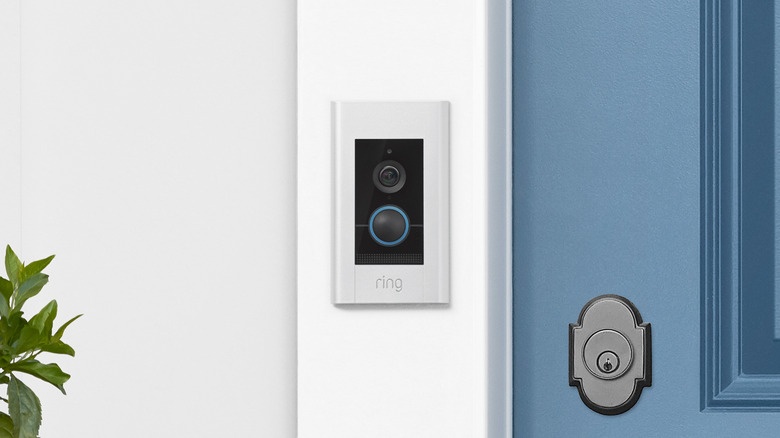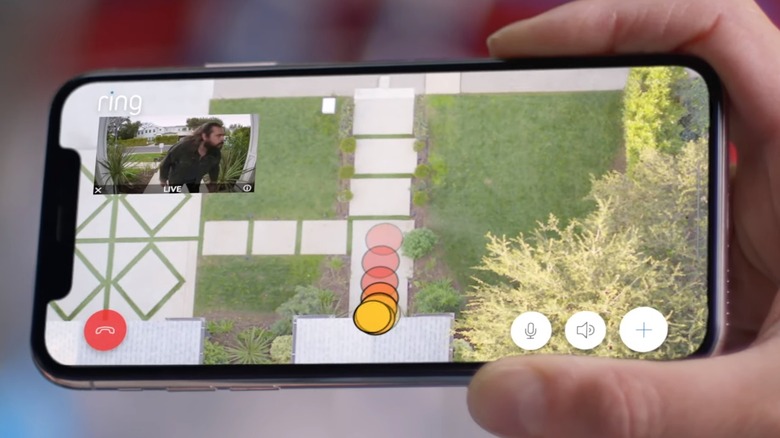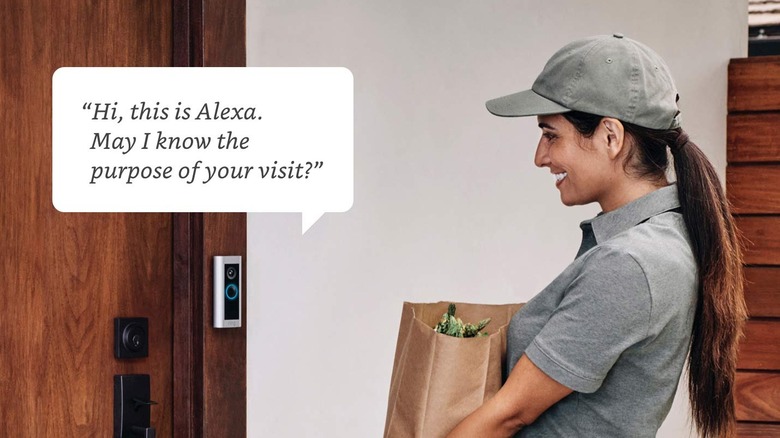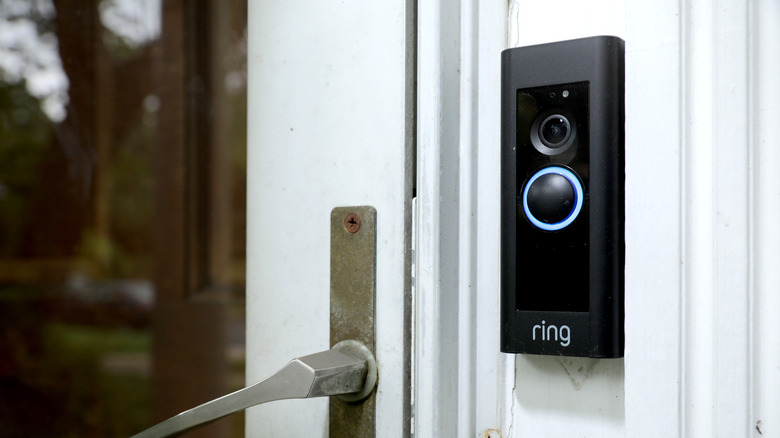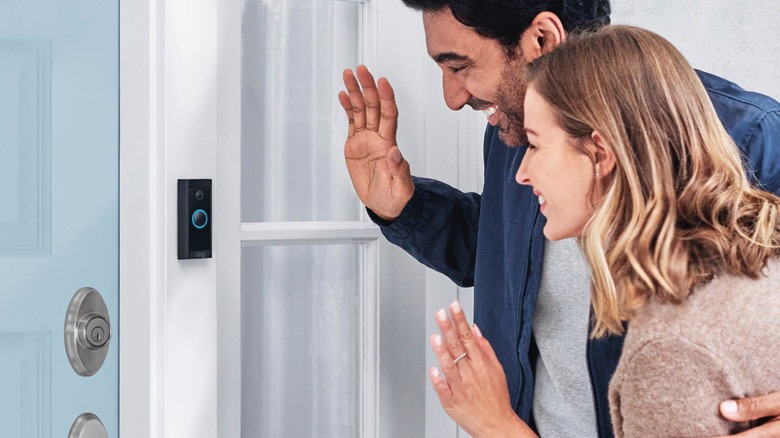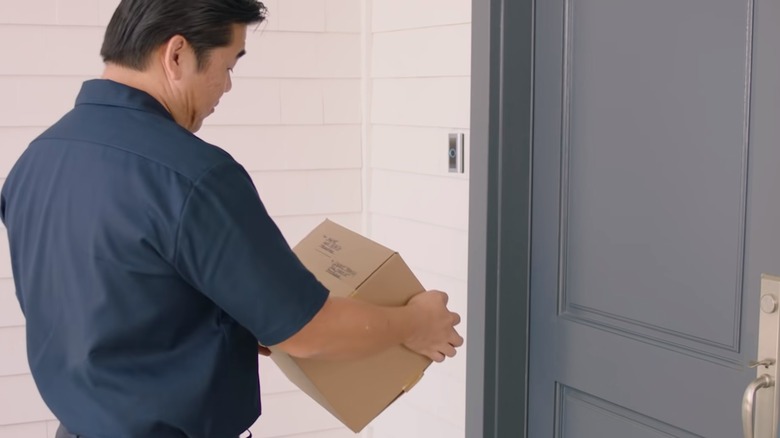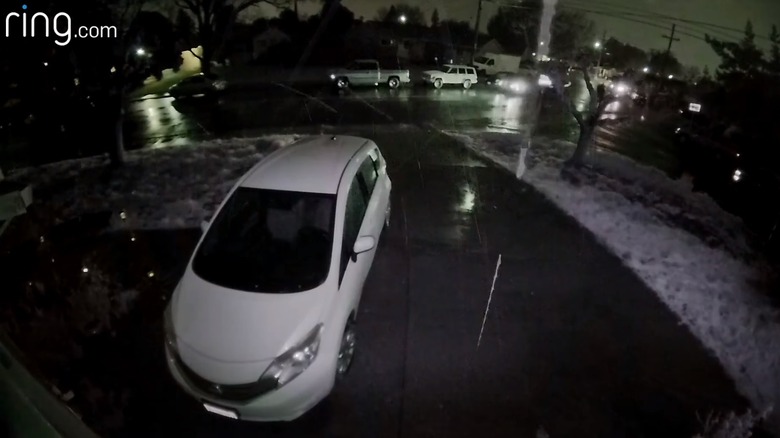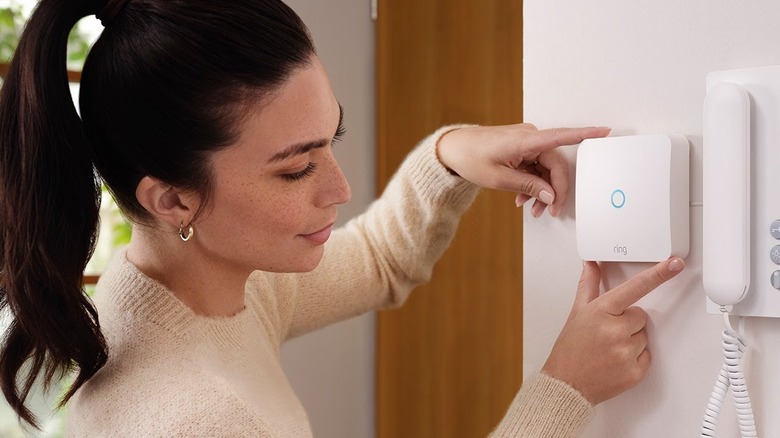Things You Never Knew Your Ring Doorbell Could Do
Since its launch in 2014, the Ring doorbell has quickly become one of the best selling smart home devices in America. At first, it was little more than a button-actuated video camera with phone connectivity, but over the years, Ring has added an entire suite of smart features to make it much more than that. There is now a range of different Ring models available, from the $65 Video Wired Doorbell to the $350 Video Doorbell Elite. Each one comes with a different suite of smart features included, and buyers who want to make use of all of Ring's smart technology will need to splash out for the Elite.
However, even the classic Video Doorbell has had a number of new smart features added over the past year or two, so current Ring owners who haven't recently checked what their device can do might be missing out. Fear not though, as we've rounded up a selection of the best features and tricks that should help you get the most out of your Ring device.
Track the pathway of a visitor
To get a clearer picture of exactly where visitors are walking when entering and exiting their property, Ring owners can enable the Bird's Eye View feature. This will show the exact path that visitors take on an aerial map view, making it easier to track exactly where deliveries are being left (or taken from, if porch pirates are an issue). The feature uses radar to keep tabs on visitors who might not be fully in the camera's field of vision, tracking their progress via a series of dots on the map.
Bird's Eye View can also be viewed by any shared users via their Ring app, and it's automatically enabled after owners set up 3D Motion Detection. It's worth noting that only newer Ring doorbells have this capability, and owners should ensure that their Ring app has been updated to the latest version to use the feature. If it's still not available, Ring recommends checking to see if the phone's operating system needs an upgrade.
Use Alexa to greet visitors
For users who subscribe to Ring's Protect Plan, Amazon's Alexa can be used to greet visitors who come to the door. Using the Alexa Greetings feature, owners can configure their doorbell to ask, ""Hi, this is Alexa. May I know the purpose of your visit?" This can either be immediately after the visitor rings the bell, or after a preset delay of up to 20 seconds. This is primarily useful in two different situations, says Ring: either to provide instructions on where to deliver a package or take a message if no one's in.
If the visitor says they're there to deliver a package, Alexa can automatically respond with instructions on where to leave it without the homeowner having to respond at all. Likewise, if the visitor wants to leave a message, that message will be available to review in the Ring app automatically. If Alexa can't identify either of these situations, it will respond, "Sorry, I can't help you with that."
Spread some holiday cheer
While Alexa integration is only available to subscribers of Ring's Protect Plan, a more basic version called Quick Replies is available to virtually every user, regardless of their subscription status. With Quick Replies, the doorbell can reply to visitors with a generic, "Sorry, we can't answer the door right now" message, but it's also able to reply with an appropriately festive response during the holiday season. According to The Verge, during the holidays every Ring can reply with, "We're busy wrapping presents right now," and it can also automatically thank delivery workers for bringing presents to the door. Ring's chime can also be set to a number of carols, including "Deck the Halls," "Jingle Bells," and "Oh Hanukkah."
It's not just Christmas that has Ring feeling festive, either. During Halloween, a number of humorous spooky replies are available for when owners are away from home. Visitors who need to declare a reason for their visit will be asked, "Tell us what brings you here...or we'll put a spell on you," while delivery drivers will be greeted with "Please leave the package (and any hocus pocus) outside."
Take a message when you're not available
As well as greeting visitors when you can't answer the door, Quick Replies is also able to take a message for you. Users with a Ring Protect Plan can view these responses as they will be recorded and uploaded to the cloud, but anyone without a plan will still be able to view them live. The Quick Replies message function works a little differently from Alexa Greetings, as with Quick Replies, users can only choose from a handful of set responses, which can be changed from the Ring app.
Three out of the six available preset responses include the option to leave a message, for example: "Thanks for stopping by. If you'd like to leave a message, you can do it now." Much like the Alexa Greetings feature, Quick Replies can be set up to be triggered between one and 20 seconds after the bell button is pressed. It's worth noting that, at the time of writing, the Alexa Greetings feature is only available in the United States, so international Ring owners will have to make do with the slightly less capable Quick Replies feature only.
Get alerted when new packages are detected
Beginning in 2021, Ring rolled out an automatic package detection feature for select doorbells including its Video Doorbell Pro 2 and Video Doorbell (2020). Like many of the other features here, in order to make use of this new addition, users will need a Ring Protect Plan. These plans vary in price from $3.99 a month to $20 a month, but they're essential for anyone looking to make their Ring device as useful as possible.
To set up automatic package alerts, you will need to open your Ring app, tap the menu in the top-left corner, then select Devices. You should then select your compatible doorbell, go to Motion Settings, and then Smart Alerts. Under the package section, select the video icon, set the package zone, then press the alerts icon. After that, you can customize the package zone so that anything delivered outside of that area will not trigger a response. The feature is then ready to use and should send a notification to your phone every time a new package is detected.
See color at night
Earlier versions of the Ring doorbell could only record video at night in black and white, which was far from ideal when it came to identifying the details of intruders and other unwanted visitors. Since 2019, however, Ring has rolled out color night vision to its entire range. The feature can be toggled on and off through the Ring app, by navigating to the Video Settings menu of each device, then selecting color Night Vision video.
TechHive reviewed the feature and concluded that although it was far from perfect, enabling color did give a slightly more accurate image than with color switched off. It requires a certain level of ambient lighting to work, so for houses without adequate outside lighting, it's probably not worth bothering with. However, it might be useful for anyone who's worried about porch pirates or burglars, as the added color should help homeowners give extra details to the police should something be stolen.
Detect sounds like glass breaking
As part of a suite of new features unveiled in June 2022, Ring doorbells will soon be automatically able to detect the sound of glass breaking. The company already markets a separate device called a Glass Break Sensor which performs the same function, but the feature will shortly be integrated into Ring's existing doorbell range, according to TechRadar. These features are being added to Ring's Protect Basic plan, the lowest tier of the available plans, which costs $3.99 a month.
Ring's existing Glass Break Sensor is able to detect sound from up to 23 feet away and has intelligent processing to determine the difference between actual glass breaking and other, similar sounds, like throwing keys or clattering plates. The sensor will automatically alert users once a break has been detected, with a notification arriving via the Ring app. While it's not been confirmed yet, it's very likely that the new integrated doorbell feature will work exactly the same as the standalone sensor.
Scan specific zones for motion detection
A common complaint about Ring doorbells is that since they are motion activated, people living in areas with lots of animals will often get false motion detection notifications. Dogs, cats, and even animals as small as spiders are able to trigger Ring's sensors, but there is a way to stop excess triggers. Ring offers a mode called People Only, where a notification is only given when the doorbell's intelligent systems recognize that a person is on the property.
It's also possible to set specific zones within the device's view that trigger different types of notifications. This level of customization is only available with Ring's hard-wired doorbells, as battery-powered units use a different type of motion detection to save power. If your device is hard-wired, you can set up multiple zones within the camera's field of view, and Ring will use pixel detection to work out if something is moving within those zones. The doorbell's local processing systems will then determine whether the moving object is an animal, a car, or a person. If you've set up a notification for, say, people, within a specific zone, Ring will send a pop-up through to your phone. But, if it's an animal or a car, it won't send you anything. This also works in other situations: For example, the doorbell can be configured to spot nuisance animals within a certain zone but ignore cars that might be driving past.
Buzz someone into your building from afar
Alongside its regular range of video doorbells, Ring also makes an intercom that's designed for renters living in apartment blocks. Like Ring's other products, the intercom requires minimal installation, as it's able to connect directly to an existing intercom handset, and it's powered by a rechargeable battery. Much like the rest of the doorbell range, the intercom connects to a user's home WiFi to provide an always-on service.
Adding the intercom to your Ring system allows for a number of extra smart features, including the ability to remotely let visitors into your home via the Ring app. When the button on the device is pressed, owners get an alert on their phones, the same as a regular doorbell. But, there's a new option to remotely open the door, allowing guests entry even when the owner is away from their property. With the Shared Users function, the intercom can also be operated by other occupants of the apartment, by downloading the Ring app on their phones. These permissions can be revoked by the system owner at any time.
